Opening Gaps: Trade ‘Em, Fade ‘Em, Or Ignore ‘Em?
Gaps occur on the euphoria of eager traders rushing into (or out of) a market on the open. This euphoria may draw in additional traders as gaps are often viewed as a sign of strength (or weakness for down gaps). However, many times opening gaps represent reversals as these Johnny-come-latelies who buy (or sell for down gaps) are the last to enter the market. This action creates a dilemma for the trader. Should the gap be traded? faded? or simply ignored? Below we will look at some ideas on how to solve this dilemma.
Trade ’em
An opening gap in the direction of the intended trade is a sign of strength (or weakness for shorts). Therefore, when market conditions are favorable and the gap isn’t too large, you should trade the open.
Obviously, “favorable conditions” and “too large” can be somewhat arbitrary. In general, favorable conditions mean that the overall market and sectors are in gear. This means they are trending strongly, or if they are not trending, are showing some signs of a major reversal.
“Too large” can be gauged in terms of the volatility of the stock and the pattern (setup) being traded. A two-point gap may be too large for a stock that barely moves two points in a week. On the other hand, a two-point gap for a volatile stock, say one that trades 5-10 points in a day, isn’t as significant. As far as pattern, if the gap is near a technical level, then the trade should be ignored. For instance, suppose you are looking to enter on a pullback. If the stock gaps all the way to the area of where the pullback began, then you have missed the move from the pullback to the old highs. Often, in this pattern, this is all you get.*
Biotech Cubist Pharmaceuticals
(
CBST |
Quote |
Chart |
News |
PowerRating), in mid-February 2000, provides a good example of when a gap should be traded. Notice that the stock was in a strong uptrend and had begun to pullback. At this time, the overall market and the biotech sector were in strong uptrends. The gap of 3/4 point in the direction of the uptrend (a) was within the normal volatility of the stock (at this time the average daily range of this stock was 2-3 points). Further, the gap was well below the first potential target of the old highs (b) (refer back to the footnote below).
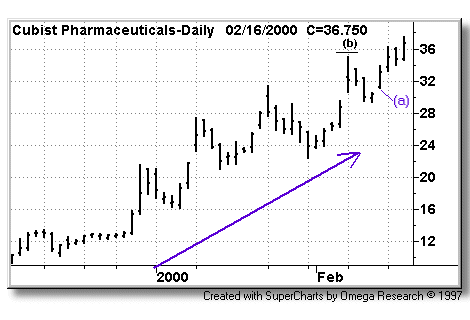
The Second Entry Option
Depending on the market conditions (especially in choppy markets), you might want to let a stock trade for 5-15 minutes to see if the stock comes in. Then you can place your order above the gap/intraday high for a “second entry.” This helps to avoid potential bad trades, as gaps can often be the high or near high for the day. The trade-off, of course, is the opportunity cost of missing a good trade if the stock gaps and never looks back.
Fade ’em
Often, especially after a strong trend, markets will gap to their final high. As mentioned above, this occurs as the Johnny-come-latelies dog pile onto a market. This is known as an exhaustion gap and is illustrated below. For the nimble daytrader, this may present an opportunity to fade (go against) the market, using a tight stop (usually right above the gap).
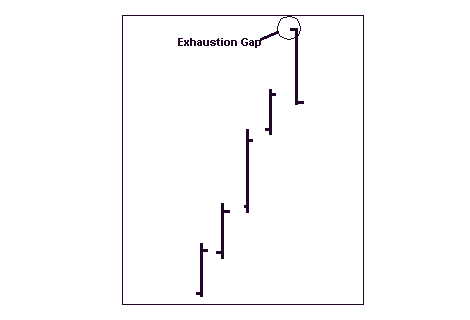
4 Kids Entertainment
(
KIDE |
Quote |
Chart |
News |
PowerRating), one of the poster children for bubble stocks, provides a great real world example. The stock gaps open to its all-time high (a) as the last of those catching Pokemon fever rush into the stock.
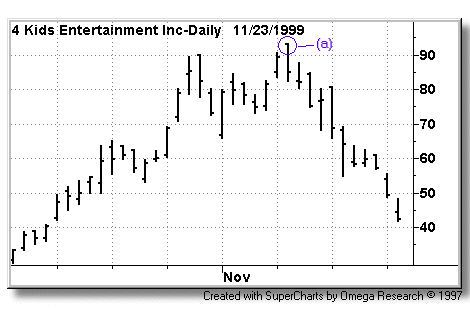
Rather than fade such a strong trend, as a momentum swing trader, I normally use these exhaustion gaps as an opportunity to take profits on existing positions.
Fade With the Trend
As implied above, as a momentum player, I normally trade in the direction of the overall trend. Therefore, I’m less likely to fade a gap (to enter new positions) unless it’s a gap against the major trend and there is a swing trade setup. In this case, I’m entering a daytrade with the hopes of it becoming an early entry on a swing trade.
For example, assuming that the overall market is strong but shows some overnight weakness, this will cause stocks to gap lower on the open, as the weak hands are scared out of positions. Then if the market and the stock begins to show signs of strength, I might look to get in as the longer-term trend resumes. This is illustrated below.
Suppose a stock is in a strong trend and pulls back. If it gaps down on the open (a) and then begins to rally (b), I may consider a daytrade where I buy the stock and put in a tight stop below the gap (a). If the stock fails, I’m out at a small loss. If the stock continues, I might get a “head start” on a decent swing trade.
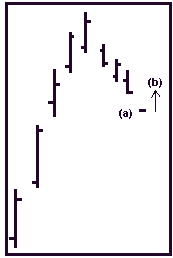
Here’s an example in the overall market. Notice the Nasdaq began to pull back from its free fall back in April 2000. The index gaps open (a) which turns out to be its exact high before its downtrend resumes.
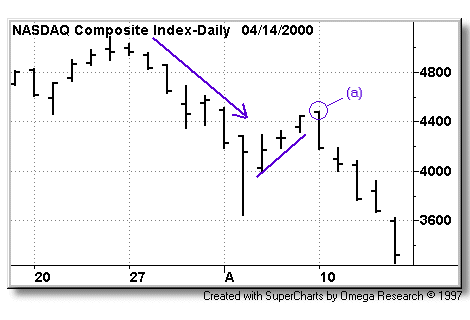
Here’s an example in an individual stock on the same day. After losing nearly 100 points, Veritas Software
(
VRTS |
Quote |
Chart |
News |
PowerRating) pulls back from lows. The stock gaps higher (a), but the gap fails to hold and the stock’s meltdown resumes.
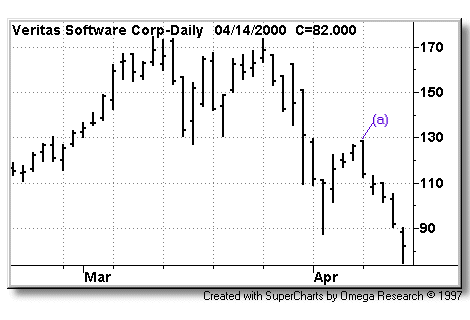
Ignore ’em
As implied under “Trade ’em,” if market conditions are not favorable and/or the stock gap is too large, then the trade should be ignored. As mentioned above, “Too large” can be gauged in terms of the stock’s normal volatility and in terms of pattern.
Here’s a real-world example. On 1/23/2001, I mentioned Lam Research
(
LRCX |
Quote |
Chart |
News |
PowerRating) as a potential pullback(a) in my “Stock Outlook.” The following day the stock gaps open over 8% (b), a somewhat extreme move, even for this volatile stock. This gap is also near the prior highs (c). Further, although the Nasdaq had been rallying off of its lows, technically, it was still in a bear market and was overextended at this time. Initially, this looked like a bad decision, as the gap held and the stock closed well above its open. However, over the next few days the stock comes back in.
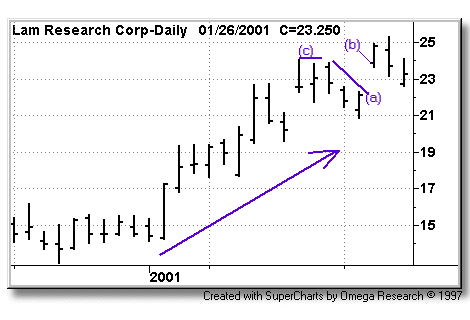
*When a stock rallies out of a pullback (a) it will either take out the old highs (b)–creating a breakout or it will stall out at this juncture–creating a potential double top. Therefore, because you don’t know which one it will be until after-the-fact, it’s a good idea to take partial profits as the old highs (b) are approached.
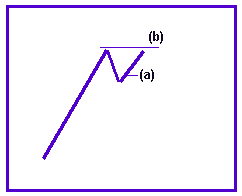
Dave Landry is principal of Sensitive Trading, a money management firm, and a principal of Harvest Capital Management. Mr. Landry is the author of two top selling books, Dave Landry’s 10 Best Swing Trader Patterns And Strategies and Dave Landry On Swing Trading. He can be reach at dave@davelandry.com.
